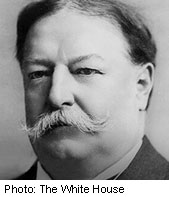
MONDAY, Oct. 14 (HealthDay News) — In recent decades obesity has reached epidemic levels in many countries, but the struggle to shed those pounds is nothing new — as exemplified by the case of the 27th U.S. president.
In 1905, William Howard Taft, who was then Secretary of War, began a long-term correspondence with a British doctor who was considered a diet guru of the time. A new analysis of their letters, published in the Oct. 15 issue of Annals of Internal Medicine, offers a glimpse into what obesity treatment was like more than a century ago, at least for a famous, powerful person.
Taft’s weight-loss plan sounds very familiar: a regimen of long-term diet change and regular exercise. As for so many people today, the plan worked well, until it didn’t.
“The science and understanding of obesity has changed, but the basic management is the same,” said report author Deborah Levine, an assistant professor at Providence College in Rhode Island.
When his weight topped 300 pounds, Taft hired the English physician Dr. Nathaniel Yorke-Davies. They communicated through frequent letters, which “sounds strange to us,” Levine noted, but was not unusual in the early 1900s.
Yorke-Davies prescribed an exacting diet: Breakfast was unsweetened coffee or tea, 6 ounces of lean grilled meat, and two or three “gluten biscuits;” lunch was another serving of lean meat, some cooked greens, baked or stewed fruit (unsweetened), and one biscuit; dinner was more of the same, but with “clear soup” and some fish added to the mix (and an optional biscuit or two).
Yorke-Davies also told Taft to regularly weigh himself and keep detailed records on what he ate and how much he exercised each day.
Over a few months, Taft’s weight dropped from 315 to 255 pounds. In a letter to his brother, Taft wrote that people were complimenting him on how well he looked. But, he added, “I am pretty continuously hungry.”
Ultimately, the weight started creeping back. At one point, Taft stopped his correspondence with Yorke-Davies, but the doctor kept after him, even writing to Taft’s family and advisors. Finding that Taft had regained 19 pounds, Yorke-Davies encouraged him to return to his “close care,” Levine writes.
Taft did resume his correspondence with Yorke-Davies, and got advice from other doctors as well. But his weight woes continued. At his presidential inauguration in 1909, he weighed 354 pounds.
That pattern of shedding an impressive number of pounds, then gaining even more back, is still a problem for many people, said Dr. Mitchell Roslin, chief of bariatric and metabolic surgery at Lenox Hill Hospital in New York City.
“It’s absolutely amazing how little progress we’ve made in 100 years,” Roslin said.
Now, obesity is far more common: About 36 percent of U.S. adults are obese, according to the U.S> Centers for Disease Control and Prevention. And increasingly, weight issues begin in childhood.
In Taft’s time, Levine said, obesity was starting to be recognized as a medical condition that could promote heart disease and shorten a person’s life. But it was a disorder that affected a minority of adults, not kids.
Today, it’s the young people who already have obesity-related health problems, such as diabetes and arthritis, who are the biggest concern, said Roslin. “We see people in their 20s and 30s who are already disabled by their obesity.”
One treatment that wasn’t around in Taft’s time is obesity surgery — where the digestive tract is altered so that a person can eat only a limited amount of food at a time. In some cases, the body’s absorption of that food is inhibited.
Roslin noted that Taft has a modern-day counterpart in New Jersey Gov. Chris Christie, who had a form of obesity surgery — a gastric-band procedure — earlier this year.
Surgery typically helps people cut a substantial amount of weight, but it’s no easy fix. They have to take supplements, carefully watch their food intake and get exercise for their remaining lifetime. Plus, there are risks, such as nutritional deficiencies.
“And even surgery doesn’t always work,” Roslin noted.
Taft’s story, he said, just reinforces the importance of preventing obesity in the first place. “We need to re-engineer our society toward prevention,” Roslin said. That includes giving children more opportunities for regular exercise, and going back to eating fresh, “whole” foods instead of packaged and prepared foods that are often laden with sugar, fat and salt.
Despite his best efforts, Taft always remained obese. When he died of heart failure in 1930, he weighed 280 pounds.
Still, Roslin pointed out, Taft was 73 when he died, which was a long life for the time. Roslin said Taft was probably able to stay “reasonably healthy” because he was so active, and did try to pay attention to his diet.
Another study in the same journal issue confirms that a healthy lifestyle can lessen the consequences of obesity. In a review of nine clinical trials, researchers found that when overweight and obese adults changed their diets, started exercising and got at least one other form of help — such as stress management — their risk of developing type 2 diabetes declined, for up to 10 years afterward.
“Our biggest worry today,” Roslin said, “isn’t so much the people like Taft, who stay active and fairly healthy. It’s the young people who already have these chronic health problems.”
More information
The U.S. National Institutes of Health has more on obesity management.
Copyright © 2025 HealthDay. All rights reserved.

